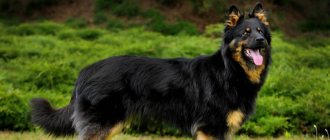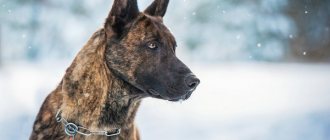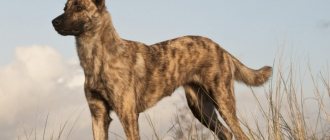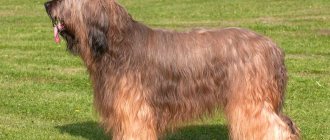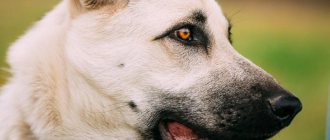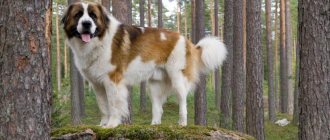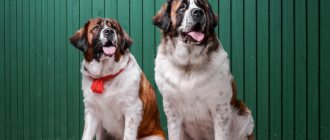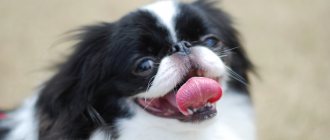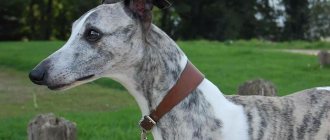Photo of an English Shepherd
| Origin: | North American continent |
| Usage: | security guard; companion dog |
| Color: | red and white; black with brown markings; black and white; tricolor combination of black, red and brown; brown with white and black |
| Dimensions: | height at withers 45-60 cm, weight 25-30 kg |
| Lifespan: | on average 13-15 years |
The English Shepherd is an obedient and friendly dog. The genetically inherent instinct of a guard is surprisingly combined with a sociable character. Distinguished by its friendliness and complaisance, the pet is ready to defend its beloved owner in case of danger.
Breed standard
It's a shame that the English Shepherd is not recognized by any canine federation in the world. The only club that has registered this breed as working group is the British Kennel Club. The Englishman has no official standards. There is only a general characteristic that corresponds to varying degrees to the appearance of the shepherd dog.
| Options | Description |
| Head | Elongated shape. |
| Muzzle | Wedge-shaped, tapering towards the nose. |
| Ears | Soft, hanging forward, triangular in shape. |
| Eyes | Dark brown color. |
| Bite | Correct. |
| Frame | Powerful, with a straight back. |
| Paws | Developed fore and hind limbs, round pads, toes tightly pressed to each other. |
| Tail | Long, straight, slightly curled upward at the end. |
| Wool | Soft, long. There is undercoat. The hair on the back of the paws and around the ears is longer than on the rest of the body. |
| Colors | Black-and-white. Tricolor: black with red and white; two-color: dark brown and white, red and white, black and white. The base is a saddle cloth of one of the listed colors, usually black or dark brown. White or red colors complement the main color. |
| Movements | Uniform trot. |
History of the origin of the species
There is a legend that the ancestors of the English Shepherd came to Europe along with Roman legionnaires. The dogs herded the herds necessary to feed the army of Julius Caesar. During one of the campaigns, some of the animals remained on the territory of the British Isles. Since those times, their appearance has changed little. Over the course of several centuries, shepherds crossed with collies and other herding dogs. This is how the formation of a new breed took place.
At the end of the 19th century, its representatives arrived on the North American continent . Farmers appreciated their working qualities. And the breeders crossed the imported dogs with border collies and got hardy, hardworking dogs capable of herding huge herds without human control. The official breed standard was approved in 1934.
Socialization
The best time to socialize a puppy is between 4 and 8 weeks of age. It is at this age that babies are taken away from their mother. The puppy is already quite brave and shows curiosity about everything new. During the period of socialization, English Shepherd puppies have a high ability to learn. They enjoy learning new commands, memorizing them instantly. If some commands make it difficult for your baby to follow, do not insist. It is better to postpone fixing them until the next day.
Patience, affection and demandingness of the owner are the basis for raising and getting used to a puppy’s new home. Walking on the puppy playground in the company of the same tomboys will allow the baby to learn an equal attitude towards them. Without such communication, the dog will grow up to be cowardly and aggressive.
Security qualities of a shepherd
Dogs of this breed are distinguished by their excellent quality of herding and guarding sheep, poultry, and pigs.
They will cope excellently with the role of a guard in the house and a hunting companion. English shepherds successfully serve in the police, the Ministry of Emergency Situations, can be guide dogs, and are also involved in psychotherapeutic programs (canistherapy).
The English Shepherd is very active and loves long walks.
How to choose a puppy
When choosing a puppy, you should not rely on the pedigree and titles of the parents, because they cannot exist. If a seller offers an English Shepherd puppy, showing the documents of titled parents, then you should know that this is a scammer. The main requirement is that the puppy must be healthy. The eyes, ears and nose should be clean and free of any discharge.
The baby's activity manifests itself in the desire to run up and sniff the stranger, to get to know him better. Cowardly puppies will huddle close to their mother. It is undesirable to adopt such a pet: cowardice can lead to uncontrollable aggression. At the time of moving to a new home, the puppy must have age-appropriate vaccinations, as evidenced by a standard document.
Suitable nicknames
For boys - English Shepherds, the following nicknames are perfect:
- Abdula, Adolf, Ad, Akbay, Akbar, Almaz, Anchar.
- Baron, Beck, Brom.
- Vulcan, Wulf.
- Guy, Count, Terrible.
- Zhigan.
- Zig.
- Indo, Ingus.
- Ogre, Omar.
- Sultan.
- Halt.
- Tsar.
Suitable nicknames for shepherd girls are:
- Alma, Alpha, Anchara, Astra.
- Vesta.
- Hera, Gerda.
- Dana.
- Willow.
- Oda, Oriana.
- Frida.
Features of maintenance and care
English Shepherds are attractive to novice breeders, those people who have no experience in communicating with dogs. This is facilitated by ease of care and maintenance. The dog will be able to live in the yard - in a kennel or in an enclosure; its thick coat and dense undercoat will protect it from severe cold. Shedding occurs twice a year - in spring and autumn. Standard combing procedures will help quickly renew the coat. If the pet is intended for apartment keeping, then the owner must provide physical activity: long walks, ball games, practicing fetch commands.
Grooming
The long, thick coat adorns the shepherd and protects against cold and skin damage. Needs simple care. During shedding, frequent brushing is recommended using a special medium-hard brush.
Ear care is important in the spring and summer, especially if the dog is outdoors most of the time. It is necessary to inspect the inner and outer surfaces of the ears for the presence of blood-sucking parasites. If a tick is found, remove it immediately.
Shepherd's teeth do not require special care and cleaning. By nature they are endowed with natural whiteness. To prevent plaque, from time to time the dog is offered to chew on bones and cartilage.
Bathing
The English Shepherd, like many dogs, loves to swim in open water. In the warm season, this is enough for the pet to maintain a neat appearance. In winter, the dog is bathed as it gets dirty. It is enough to wash your four-legged friend with animal shampoo once a month. If the weather is slushy outside, then upon arriving home, the paws and belly are washed, dried, and the dog is left indoors without drafts.
Walk
These animals are herding dogs by nature and historical purpose. Natural instincts are inherent in this breed. It is advisable to walk your dog at least twice a day. To give an outlet for energy, the owner must provide the pet with feasible physical activity. The Englishman is happy to take long walks and long hikes. With pleasure accompanies the owner on outings into nature. For a passive or lazy person, it is better to get a pet of a different breed.
Character
The English Shepherd is proportionally built, quite playful, and is not afraid of long distances, even if there are various obstacles on the way such as hills and swamps. The dog has a unique gift for quickly changing its course of movement.
The English Shepherd can make independent decisions, but prefers to work in tandem with its owner. She loves to complete the tasks assigned to her and receive a well-deserved reward for them.
The dog is smart , in the current situation it knows what needs to be done. He works without unnecessary fuss, clearly and competently.
And even in an unusual environment, the dog quickly makes decisions about its further actions. You can be sure that the dog will find the lost animal and return it to the herd, no matter what the circumstances.
In his free time from work, the dog enjoys lying on the grass, running after a ball, and playing with children. There is no need to be afraid of leaving the “English girl” with the children.
If the dog is kept in the city, you should not deprive it of time for energetic rest. An excellent replacement for natural herding work is agility, frisbee and flyball.
English Shepherds are used in so-called animal therapy , when the dog helps sick people. Only really smart dogs are capable of this, which includes animals of this breed.
The exceptional talent of these dogs is the ability to climb trees.
Feeding
The food plan is selected by the owner based on his employment. The shepherd dog does not have any special health problems that depend on nutrition. But this does not mean that English Shepherds should eat leftovers from the master's table.
When feeding dry food, strictly follow the instructions on the packaging and observe the recommended feeding dose. Dry food is convenient because you don’t have to waste time preparing soups and cereals for your pet. The granules contain all the necessary nutrients, microelements and vitamins that satisfy the animal’s needs. If the dog is on dry food, there should be no restriction in liquid! Fresh, clean water should be available at all times. When choosing a natural diet, an English shepherd dog should receive the necessary daily intake of fats, proteins, carbohydrates and microelements that allow it to lead normal life activities. It is necessary to undergo a course of vitamin therapy once every three months.
List of permitted products:
- Cereals.
- Lean meats.
- White fish.
- Offal.
- Fresh vegetables and fruits.
- Large bones.
List of prohibited products:
- Smoked meats.
- Pickles.
- Bakery.
- Confectionery.
- Tubular bird bones.
Training
The dog requires regular training and long walks. It is better in an open area so that the pet can run around as much as possible.
Special dog parks are best suited for targeted training. The dog will really like the classes.
Without proper exercise, the dog will look lethargic. Training can begin at 6 months. The dog will learn ordinary commands without difficulty. Complex commands will require more time and effort, but you won't regret it.
The pet must have toys, three are enough. The “English woman” has an excellent memory, so you shouldn’t offend her. In this case, you will not achieve her respect.
Video
We recommend reading:
- An enclosure for a dog: how to make a beautiful warm outdoor enclosure with a winter road with your own hands - drawings, sizes, photos, projects, tips on how to build it yourself
- DIY dog house, design of a beautiful large dog house with a veranda, kennel in the apartment
- Caring for a dog's fur: how and what to comb properly, combs for long, short-haired, smooth-haired dogs, how to comb tangles, products - shampoo, spray
- Knitted clothes for small dogs - knitting patterns
Price
It is very difficult to purchase a puppy of a rare breed in Russia; it is better to look for a pet from breeders in Europe or the USA. It is worth excluding the search for dogs in markets and from private owners. External resemblance to a pedigree dog does not guarantee the development of working qualities or manifestations of a benevolent character in an animal.
In a specialized nursery, information about the pedigree and vaccinations at the time of sale must be prepared for each puppy. It is recommended to pay attention to the degree of relationship between the parents, as this is the cause of genetic abnormalities in the offspring. The price of an English Shepherd cannot be low; it averages 40,000 rubles.
Buying a puppy for exhibition purposes or sports competitions can cost twice as much. The price is influenced by many factors, including the age of the dog, the type of color, the purity of the parent's breed, the health of the puppy, even the popularity of the kennel. The main features of the pet that you should pay attention to:
- clean fur;
- a good appetite;
- mobility, activity, manifestations of curiosity;
- shiny eyes, wet nose;
- sensitive hearing (to check, you can drop the keys nearby).
Puppies, when introduced, happily make contact with any person. If a dog is cowardly, then it is no longer suitable for a guard. Aggressive manifestations will cause many problems later. The first observations of a puppy's behavior provide important information.
Mating
For the purpose of further breeding, English Shepherds that have reached the age of two are used. By this time, the bitch must undergo scheduled deworming measures (expulsion of worms), as well as all vaccinations required by age. Only in this case will puppies be reliably protected from major diseases during the first 8 weeks of their life.
Description of the Icelandic dog
Currently, Icelandic Shepherds can still be found on pastures in remote areas of Iceland, where they carry out their direct duties - herding sheep. They are used extremely rarely for hunting, but occasionally they help in the search for missing people and animals, and also perform guard functions. However, most often shepherd huskies are kept as companions and family pets, actively participating in all kinds of dog competitions and exhibitions.
Breed standard
The Scandinavian Shepherd is a well-built, lean, Spitz-shaped dog, slightly below average height, with a strong, slightly squat bone structure and well-developed muscles. A compact body of a stretched rectangular format with a flat, strong and muscular back, a not very long, wide, sloping croup, an elongated, deep, widened sternum and a slightly tucked belly. Males are noticeably more powerful and larger than females.
The Icelandic Shepherd is a small, but well-cut and compact dog.
Breed standard:
- A strong wedge-shaped head with a dome-shaped skull and a triangular muzzle tapering towards the nose, slightly longer than the skull, set on a high, curved, moderately long neck (without dewlap). The stop is clearly expressed.
- The nose is pigmented black or dark brown (in dogs with cream and chocolate coats).
- Jaws in a scissor bite with a full set of teeth. Black or dark brown lips fit tightly.
- The almond-shaped eyes are small with black eyelids. The iris is dark brown in color; in cream and chocolate individuals it is slightly lighter (brown eyelids). The look is smart, cute, cheerful and happy.
- Ears with rounded tips, triangular, erect, small, well express the mood of the animal, sensitively reacting to all sounds.
- Muscular, even, parallel legs, oval paws with arched, strong toes, tightly knit, and elastic pads.
- The high tail is curled into a ring and thrown over the back.
- Height at the withers (ideal): for bitches - 42 cm;
- for males - 46 cm.
Features of the coat
The coat is very dense and thick, two-layered. There are two types of wool:
- Short coat, consisting of a rather coarse guard hair of medium length and a delicate soft undercoat. On the neck and chest the hair is longer, forming a collar, on the hind legs there are feathers, and the tail is well feathered. Shorter hair on the front legs and head.
- Long coat of roughish guard hair and thick soft down. Long hair on the back of the ears, chest and neck, feathering on the limbs, short hair on the top of the head, on the muzzle, as well as on the front of the ears and legs.
The Icelandic Shepherd's coat can be quite short.
The standard allows the following dominant colors:
- grey;
- black;
- all shades of red (orange);
- chocolate brown.
The main predominant tone is always followed by white markings (on the head, chest, limbs, tail). The fur on the belly and the entire lower part of the body, including the bottom of the tail, is a lighter shade. Individuals with light fur (gray and red) have a dark mask on their muzzle. Dogs with a dominant black coat have a tricolor color; along with the traditional white spots, there is a red tan on the paws, cheekbones, and characteristic eyebrows above the eyes. Variegated colors are allowed, when there are multi-colored spots on a white background.
Disadvantages and disqualifying characteristics
A defect is any deviation from the breed characteristics, its severity is assessed based on the degree of severity, as well as its effect on the well-being and health of the animal. Disadvantages include a black back in red dogs or solid black coloring (no spots).
The vices are:
- bulging or round eyes;
- yellow iris;
- absence of dewclaws.
Interesting Facts
British dogs are designed to inspire people to live active lives. Smart and energetic pets never cease to amaze with their talents:
- the English Shepherd in the photo appears calm and unperturbed, but in everyday life the passion for hunting is manifested in dexterity unprecedented for dogs - it, like a cat, climbs trees to catch a bird or a squirrel;
- in a shepherd's litter you can count up to 16 puppies - not every breed can boast of such productivity;
- The sensory perception of animals allows you to capture the most subtle movements of the soul of its owner - the dog is ready to make every effort to dispel negative vibrations and help the person.
This amazing breed amazes with its combination of amazing professional qualities and the kindest nature in everyday life. Throughout the history of communication between English shepherds and humans, dog owners have expressed only admiration for their selfless and devoted friends.
Diseases
The English Shepherd is prone to hip and elbow dysplasia. Some dogs inherit a gene that makes them sensitive to drugs. Some medications can be fatal, so your English Shepherd should only be treated by an experienced veterinarian and avoid self-medication.
In general, we can say that the breed was created in natural conditions without the intervention of breeders, so the dog is in good health. The dog does not suffer from chronic diseases.
Dossier
Adult height: males 58-61 cm, females 46-61 cm. Weight: 18-32 kg. Characteristic color : white-black, red, tricolor. Coat length: medium length with thick undercoat. Life expectancy: 12-15 years. Advantages of the breed: obedient, friendly. Difficulty of the breed: almost non-existent. Average price: $50. Classification: medium breed, guard, hunting, companion dog.
